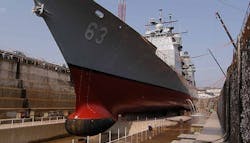Navy asks CTG to build sonar transducers for cruiser and destroyer hull-mounted sonar arrays
Officials of the Naval Surface Warfare Center in Crane, Ind., have announced a $34.4 million contract to CTG TR-343 sonar transducer ship sets. A shipset consists of 576 TR-343 sonar transducers and one set of AN/SQS-53C array hardware.
The AN/SQS-53 hull mounted sonar array is a large bulb-like structure built into the bows below the water line of U.S. Navy Arleigh Burke-class destroyers, Ticonderoga-class cruisers, and Japanese navy Kongo-class destroyers. The AN/SQS-53 is a component of AN/SQQ-89(V) acoustic sonar weapons system for surface warships.
The AN/SQQ-89(V) is an integrated surface ship undersea warfare combat system with the capability to search, detect, classify, localize, and attack enemy submarines.
The contract calls for CTG to build and test as many as 12 TR-343 sonar transducer ship sets for new-build Navy Burke-class destroyers, Navy officials say. The government of Japan will receive 15 percent of the TR-343 sonar sets for its Kongo-class destroyers.
CTG will begin delivering the TR-343 sonar sets in December 2015 and deliver additional sets about every five months until the company completes the contract.
Related: Lockheed Martin to provide Navy with advanced towed-array sonar for surface warships
The surface ship AN/SQS-53 is a computer-controlled surface-ship sonar that has active and passive operating capabilities providing precise information for ASW weapons control and guidance.
The AN/SQS-53C, the latest version of this hull-mounted sonar system, retains the transducer assembly from either the AN/SQS-53A and 53B, yet provides greater range and detection capability with only half of the electronics footprint and less weight than earlier versions.
Constructed in standard electronic modules, the AN/SQS-53C is an all-digital system that provides apparent range, bearing, and true bearing of submarine contacts with active sonar and true bearing of contacts with passive sonar.
Related: Navy awards sonar processing contract to General Dynamics; readies for next phase of A-RCI
Active sonar transmits a ping to bounce sound waves off the hulls of submarines. Passive sonar means simply listening for the sounds of submarines and surface vessels. This system is the basic sonar watchstanders tool to keep an eye on all traffic; the system often detects other surface ships at greater ranges than most radar systems.
The AN/SQS-53 can detect, identify and track several different targets and interfaces with the host vessel's digital computers. It has three active modes of operation: surface duet, bottom bounce, and convergence zone. It also can ping off buoys to pinpoint its own location in foreign ports.
For more information contact CTG online at www.channeltechgroup.com, or the Naval Surface Warfare Center-Crane at www.navsea.navy.mil/nswc/crane.
